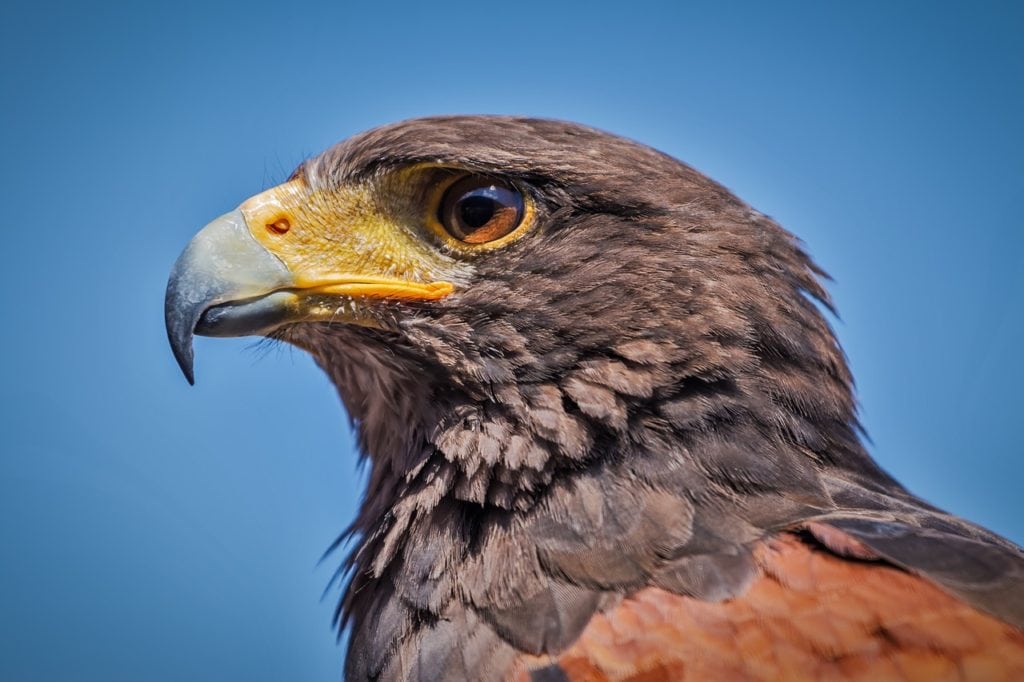
At the mention of the state of Florida, one image that comes to mind is that of recreation and entertainment. However, beyond the tourist attraction heritage, the state of Florida is also a perfect destination for bird watching opportunities.
The hawk is one of the most stunning and rare birds found in Florida. Their eyesight is the best you can find in the animal world. They are strong and powerful birds of prey and are known to have mixed personalities. There are some hawks that are fierce and some that are gentle and quiet.
All through the state of Florida you will find several types and species of hawks. If you want to learn more about hawks in Florida and how to identify them with ease, then this guide is for you.
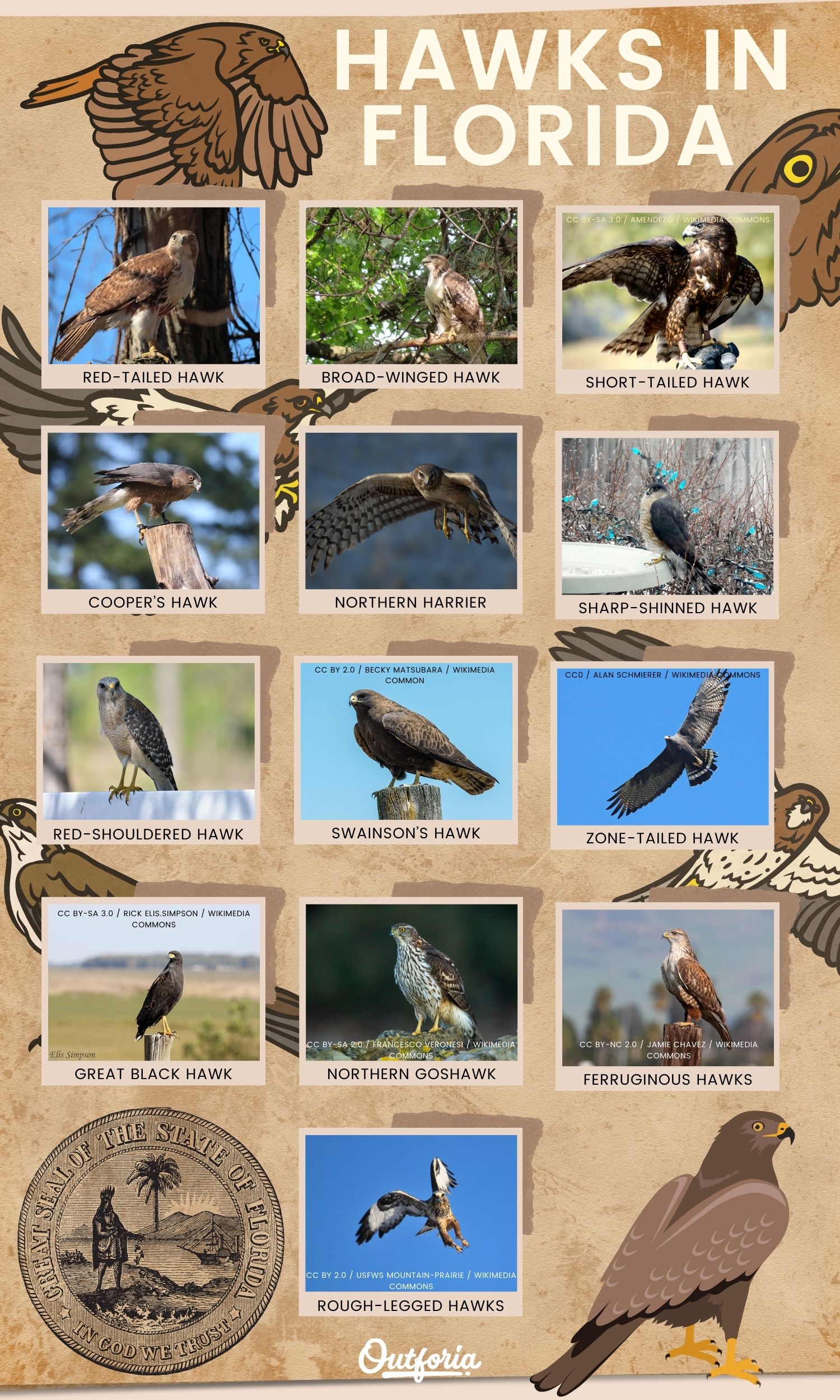
Share This Image On Your Site
<a href="https://outforia.com/hawks-in-florida/"><img style="width:100%;" src="https://outforia.com/wp-content/uploads/2022/04/Hawks-in-Florida-infographics-04022022.jpg"></a><br>Hawks in Florida Infographic by <a href="https://outforia.com">Outforia</a>You May Also Like: Check Out These 20 Florida Spiders You Need To Know About complete with Photos, Infographics, Facts, and more!
13 Types of Hawks in Florida
1. Red-tailed Hawk
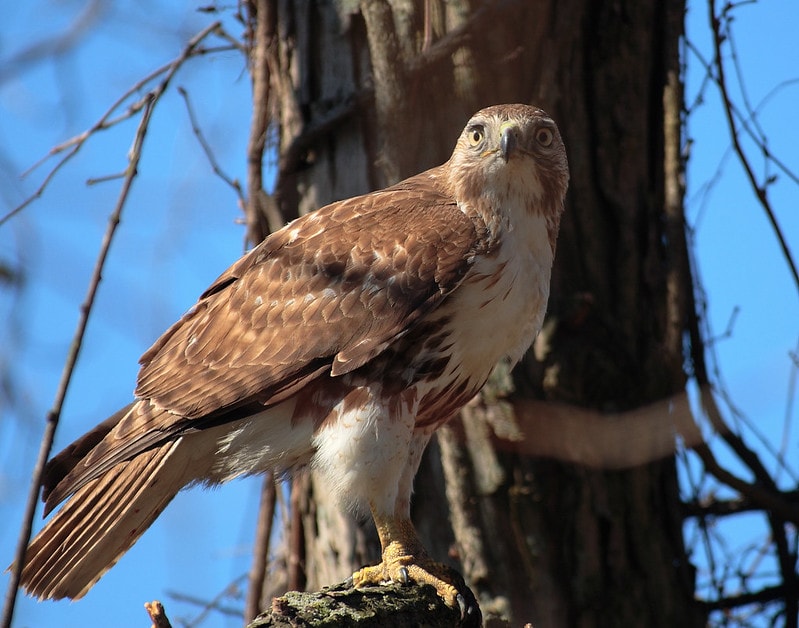
Red-tailed Hawks are probably the most common and familiar hawks you will find in North America. You will often find these large raptors on the countryside long drives – either perched on the post of a fence or soaring in the sky.
The red-tailed hawk, as their name suggests, is characterized by their red-tail, with a length of 38-43 cm (15-17 in). Bear in mind that their females are larger. They also have a broad wing with a span of 90 cm (35 in) for soaring effortlessly. This hawk comes in variable plumage color, which can range from off-white to black. This implies that you can’t reliably identify them by their coloration.
The red-tailed hawks are endowed with an amazing vision that helps them spot their prey from a very far distance and heights. They also have big claws on their feet, and this helps them grab their prey tightly.
Red-tailed Hawks are known to be highly adaptable when it comes to their habitat. They can be found by the roadsides, in rainforests, scrublands, woodlands, and all kinds of fields with some high perches and open hunting grounds.
The primary food sources of Red-tailed Hawks are mammals, with their main victims being mice, rats, voles, rabbits, and ground squirrels. Sometimes, you may find them feeding on larger birds like pheasants, starlings and blackbirds; carrion and snakes.
2. Broad-winged Hawk
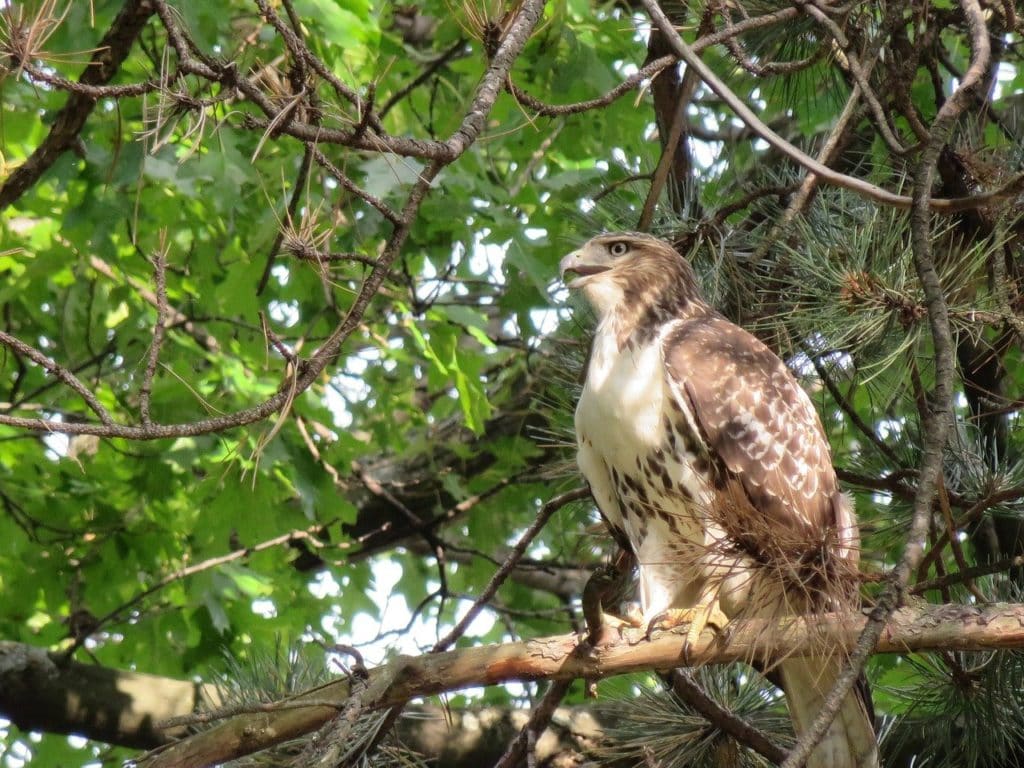
The Broad-winged Hawks are compact and small-sized raptors with large heads and chunky bodies. They have a characteristic broad wing which only becomes distinct when in flight.
An adult Broad-winged Hawk is characterized by reddish-brown heads, white and black bands on the tail; and barred underparts. The undersides of their wings are pale with dark brown borders.
Juveniles on the other hand are lighter brown with coarse streaked underparts, and narrowly banded tails.
Broad-winged Hawks inhabit forests and deep woods, spending a large part of their time underneath the canopy. During migration, they can be found soaring along mountain ridges and coastlines.
During nesting, these hawks tend to be inconspicuous, building their nesting from the reach of other birds of prey, and fiercely protecting their nesting site
Typical of most birds of prey, their diet consists of birds, amphibians, small mammals, and reptiles. They favor the likes of ground squirrels, mice, rats, lizards, snakes, voles, and so on.
3. Short-tailed Hawk
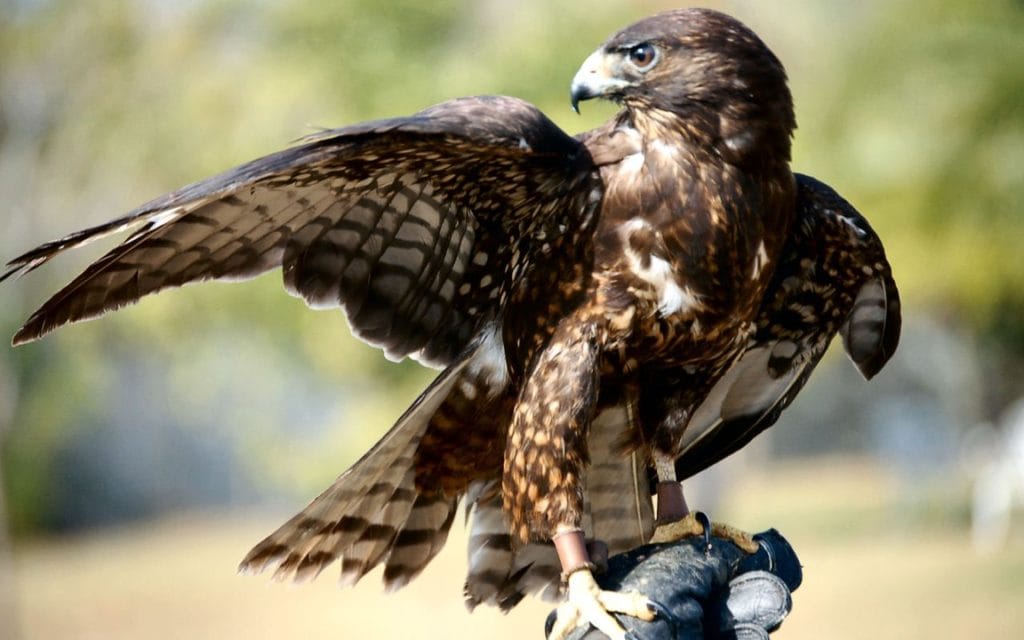
Short-tailed Hawks are very rare fun birds to see while bird watching in Florida, characterized by their solid color underparts, tail feathers and striped wing. They are a small-medium-sized species of hawks in Florida with a length ranging between 37-43 cm (14.6-16.9 in), a wingspan of 85-95cm (33.5-37.4 in) and weight ranging between 390-450g (0.85-0.99 lbs) .
This hawk occurs in two color morphs – Light or Dark morph. The former is more common and is uniformly dark brown with dull white and thin dark bands, and dusky-barred gray flight feathers. The latter on the other has white underparts.
Short-tailed Hawks generally have light yellow feet and legs, with black talons. Juvenile short-tailed hawks have dusky heads, with pale eyebrows and white underparts.
In the United States, this species of hawk is only found in Florida and stays airborne for the most part of its entire day. Short tailed hawks love to inhabit wetlands, bays, mangrove and cypress swamps, and patchy woodlands.
Don’t be deceived by this hawk’s name, it does not particularly have a short tail. One distinguishing behavior of this hawk species is that it flips its wingtips up into the air when soaring, unlike the flat wing profile of most raptors during flight.
Their breeding habitat is usually dense mature woodlands. Nesting is usually done on tall tree tops such as cypresses, with the males providing the nest material while the females prepare the nesting site.
Short-tailed hawks mostly have their diet consisting of small birds such as eastern meadowlarks and red-winged blackbirds. They are also found feeding on snakes, lizards, frogs, insects, and rodents.
4. Cooper’s Hawk
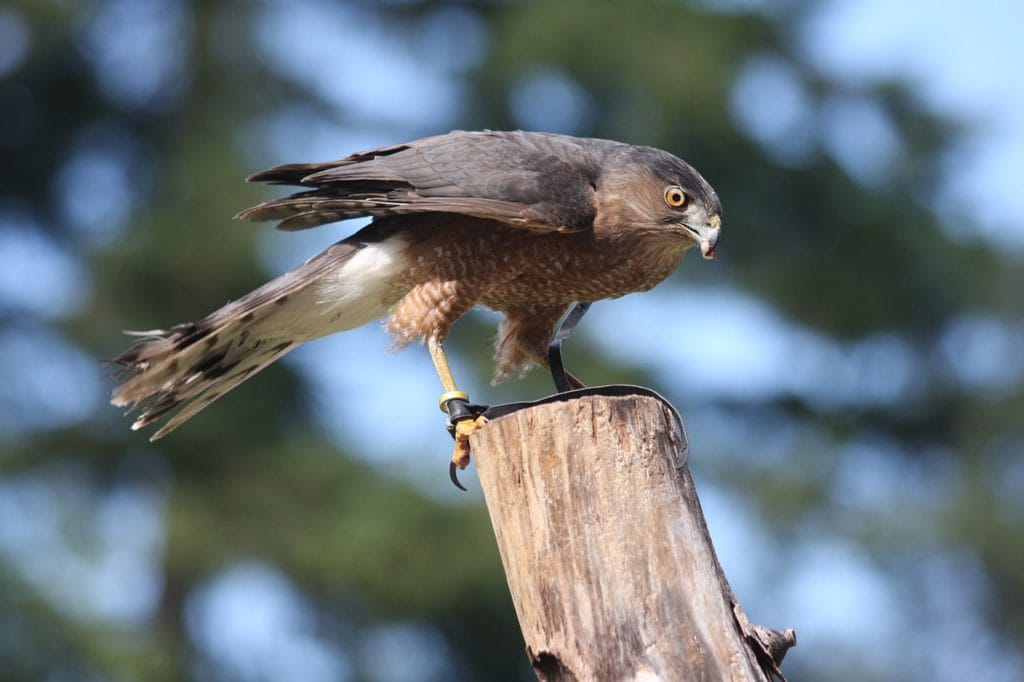
Cooper’s Hawks are medium-sized raptors that are found all year round in Florida. They are characterized by a rounded tail and relatively short rounded wings. The Cooper’s hawk is one of the prettiest hawks in Florida with its characteristic bluish-black back, red eyes and black wings.
Adult Cooper’s Hawks have their upper parts colored in gray, red eye, black cap, with pale orange barring underpart. Juveniles are streaky and browner. They have a short and strongly hooked bill.
Cooper’s Hawks favor wooded habitats from leafy subdivisions, to deep forests to and even backyards. There’s probably a cooper’s Hawks living somewhere close to you if you live in North America. Their breeding habitat mainly consists of forested areas, ranging from mixed and deciduous forests, small woodlots, open woodlands, and forested mountainous regions.
Unlike most birds of prey, cooper’s hawks hunt for their prey in dense forest settings. Thanks to their adaptation such as long tails and rounded wings, they can maneuver their way through tight spots to capture their prey.
The Cooper’s Hawk hunts is a highly opportunistic predator, and as such feeds on almost whatever it finds along its path. Cooper’s Hawks are primarily carnivores. However, they are known to feed on small- to medium-sized birds such as woodpeckers, doves, and quail.
They may also prey on bats, squirrels and mice. Although less often, they prey on frogs and snakes as well.
Nesting is done mainly in forest settings, with their males doing the majority of the nesting work. It is the responsibility of the females to care for the eggs after laying.
5. Northern Harrier
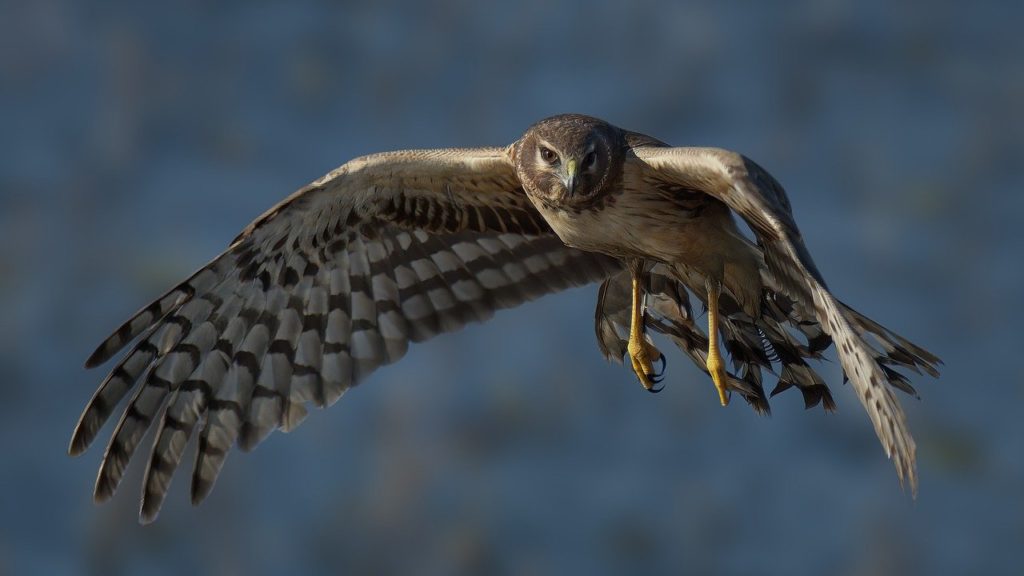
Northern Harriers are slender, medium-sized hawks with a relatively long, barred tail and distinctive owl-like facial disk and white rump. This species of Hawks in Florida, together with their Harriers family are presently endangered throughout North America. If nothing is done, they may gradually go extinct.
The northern harriers are fondly called unusual hawks because their sexually dimorphic plumage; which is more than the typical of raptors.
Male northern harriers have their upperparts colored in gray, their underparts in an unmarked lighter color; and have black wingtips. Females on the other hand have brown colored upper bodies and streaked buff colored undersides.
One characteristic that can help enthusiasts distinguish this hawk species from others are their white rump patches that are visible during flight. Juveniles have a brown colored upperpart and plain orange-brown underpart.
Northern Harriers are often seen in hilly habitat, grasslands, farmlands, and parks. They favor dense clumps of vegetation when it comes to building their nest – particularly on the ground. Northern Harrier males can have as much as five mates at the same time. The male usually initiates the nest building process, and then the female takes over construction to completion.
More than just their vision, Northern Harriers rely on their hearing to hunt, and they often drown their prey, especially the larger ones. Northern Harriers prey on mostly small birds and small mammals, even though they are capable of hunting down bigger prey like ducks and rabbits. Northern Harriers are opportunistic eaters, where their diet varies based on availability of prey.
6. Sharp-shinned Hawk
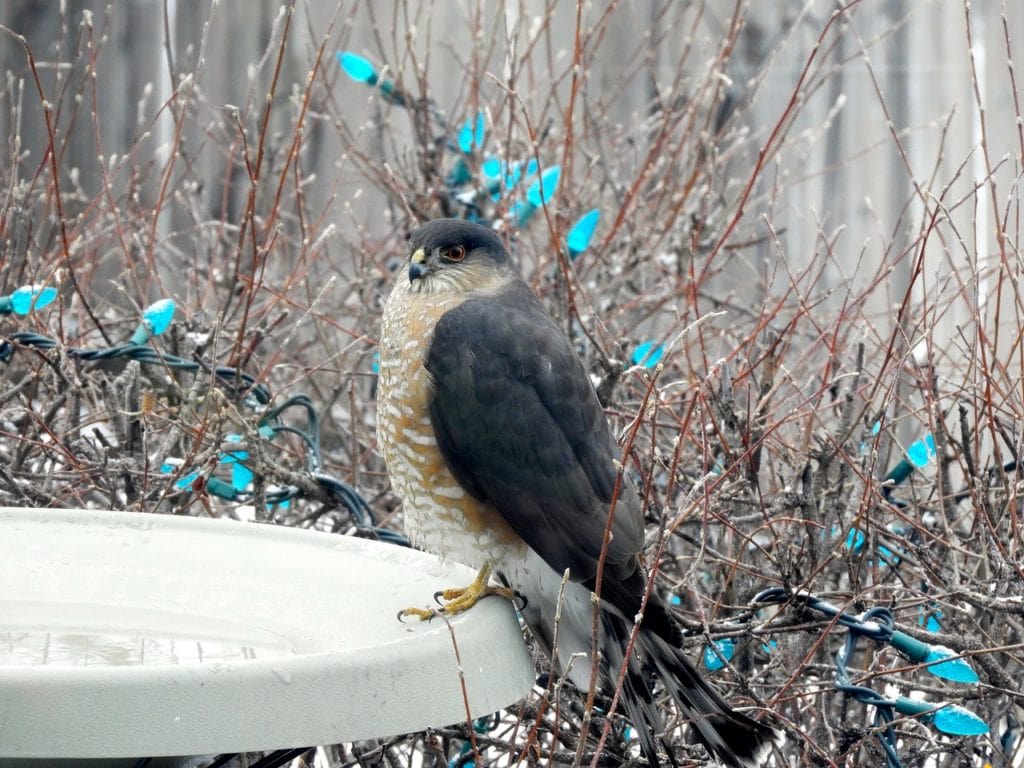
The Sharp-shinned Hawk is a small long-tailed hawk in Florida, the United States. When it comes to birds of prey having a striking beauty, this is top on the list. Sharp-shinned Hawks have relatively smaller heads, short rounded wings and less distinct gray caps, especially when compared with the Cooper’s.
Adult Sharp-shinned Hawks are characterized by red eyes, barred, solid gray upperparts and reddish-brown underparts. Their tails are long and squared and feature black and gray bars with white narrow tips. Juveniles have yellow eyes, brown upper bodies with streaking diffuse brown underparts.
When it comes down to their habitat, Sharp-shinned Hawks aren’t too picky. They can be found anywhere from lowland habitats, high montane forests, coniferous forests, suburban areas, agricultural fields, hedgerows, and coffee plantations. Backyards are not left out. In fact, Sharp-shinned Hawks are known for stalking backyard feeders; so if you see them around, be mindful of your feeders.
In winter these hawks can be found in enclosed bushy areas and forests. Nesting is done in concealed areas, usually 20-60′ above ground in dense conifers such as fir and spruce, and within thick grove or forest. Females usually do the construction while males help in putting together the materials.
The Sharp-shinned Hawks are adept at maneuvering through thick vegetation, and so take on their prey using short bursts of flight and the element of surprise. They primarily prey and feed on small birds; however, they may also take small mammals, insects, lizards and frogs.
7. Red-shouldered Hawk
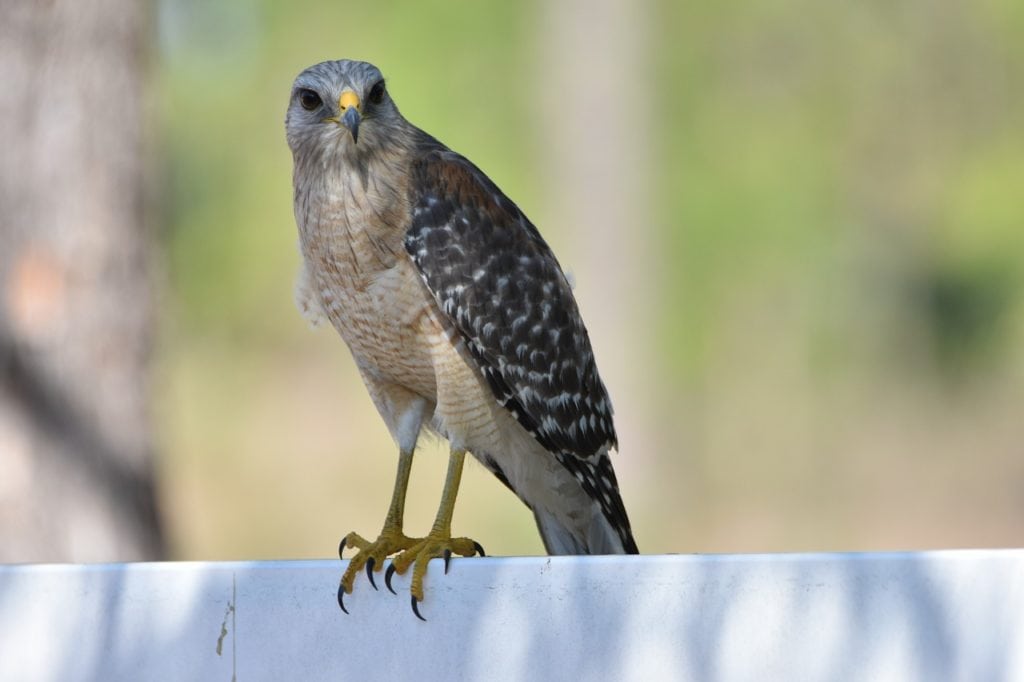
Red-shouldered Hawks are medium sized hawks with slim shaped bodies and somewhat long tails. They have broad and fairly square wings. Adult red-shouldered hawks are characterized by reddish brown upperparts, barring rich orange underparts, and banded white and black flight feathers and tail.
This species of hawks in Florida are very territorial and solitary. These hawk species have increased in their range over the last 50 years. Their greatest threat has been clearing of wooded areas which consist a large part of their habitat.
Red-shouldered Hawks are known to primarily inhabit wooded areas and forests. This habitat also constitutes their nesting habitat. During nesting, both the male and female are involved in constructing the nesting site, which is done with sticks, lined with leaves or twigs. They are known to re-use the same nest year-in year-out.
Red-shouldered hawks mainly favor bottomland woods, swamps, and wooded stream sites. Nesting is done in deciduous and mixed forest with nearby rivers and swamps. Winter is done in open habitats such as oak woodland, riverside forests or mangroves.
Red-shouldered hawks in Florida are equipped with adaptations such as sight and hearing to help with locating their prey. This Florida bird species generally prey on birds, amphibians, small mammals, and reptiles. This may actually vary with season.
Their diet primarily consists of chipmunks and voles, and toads and frogs. They may be found eating crayfish in some areas. Not left out in this list are snakes, mice, fish, and large insects.
8. Swainson’s Hawk
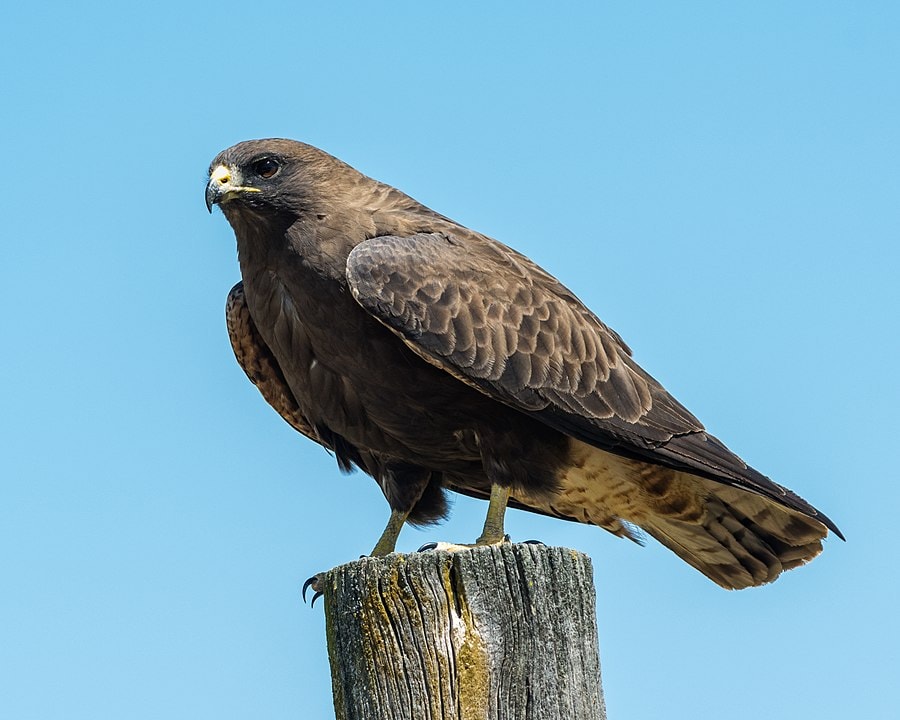
Swainson’s Hawks are beautiful large Hawk species with relatively broad, long wings with distinctive white-lined underwings, and short gray brown tails. These hawks are often spotted soaring above plains, farmlands, dry grasslands, and ranches. This large hawk measures up to 43–56 cm (19-22 in) in length, 122-137 cm (48-54 in) in wingspan and weight of up to 500–1700 g (1.5-3.5 lbs).
Similar to the short-tailed hawk, the Swainson’s hawk comes in two different morphs and color patterns – light and dark morph.
Light-morph hawks are characterized by cream-colored, mottled breasts and a distinctive white-patched throat. Across the upperparts of the breast is a reddish band running through. Their dark morph individuals are covered with a uniform chocolate brown overall, and a distinctive lighter-colored band on their tails.
Despite their difference in morphs, most males tend to have gray colored heads and females have brown colored heads. Both sexes have light bellies with a reddish or dark-brown chest and gray or brown upperparts.
Swainson’s hawks are monogamous and can repeat a nesting site year after year. Nesting is usually done by both mate partners in a large shrub or tree in open areas, usually about 30′ above ground. During breeding, they can be commonly found in prairie regions having scattered groves of trees.
Swainson’s hawks are carnivores and as such hunt mainly mammals and insects. They are often seen feasting on insects such as grasshoppers, beetles and locusts; which makes them a farmer’s good friend. There have been times when this species of Hawks have been seen hunting other, smaller raptors such as the American Kestrels and Aplomado Falcons.
9. Zone-tailed Hawk
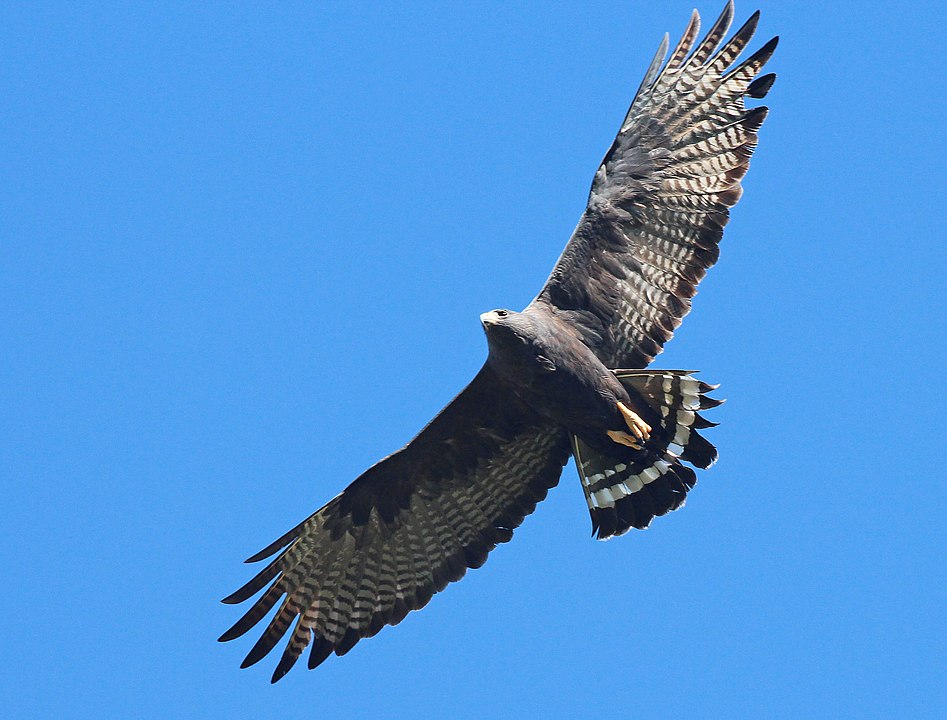
Zone-tailed Hawks are medium-sized all-dark raptors with slim, broad wings and long tails. They live on river woodlands, canyons and desert mountains; forages grassland, chaparral, or desert.
Adult Zone-tailed Hawks have black underparts with their flight feathers heavily banded and dark bold trailing edge. Their tails have 2-5 inner bands which are seen when they spread.
There is usually a slight difference between males and females of zone-tailed hawks: Males have a slightly different tail pattern from females, and also have a bit more bluer-cast to the chest and back compared to females. Females are slightly larger than their male counterparts.
Juveniles are quite similar to adults, but come with fine white spotting on the belly or breasts, finely banded flight feathers and tail.
Zone-tailed hawks are somewhat similar to turkey vultures and often like to use this characteristic to their advantage, especially during times of hunting. During their hunting adventures, they have a similar flight style to vulture: slowly and rather low over uneven terrain, and when a prey is spotted, they fall suddenly onto it.
Nesting is done in very large isolated trees along riverside, near cliffs, or in canyons. Like any typical hawk, the nest of zone-tailed hawks consists of a collection of sticks lined with green leaves, and built on tree tops, particularly on the main branch. Incubation of their eggs could take between 28-35 days.
Adult Zone-tailed hawks grow up to around 45-56 cm (17.7-22 in) in height, with wingspan of about 78-78.6 cm (29.9-30.9 in), and weight of around 610–940 g (1.34-2.07 lb). They primarily feed on birds, amphibians, reptiles and mammals; but can be spotted eating fish.
These migratory birds are generally not harmful or hostile to humans, except they feel threatened, and as such will attack surprisingly from behind.
10. Great Black Hawk
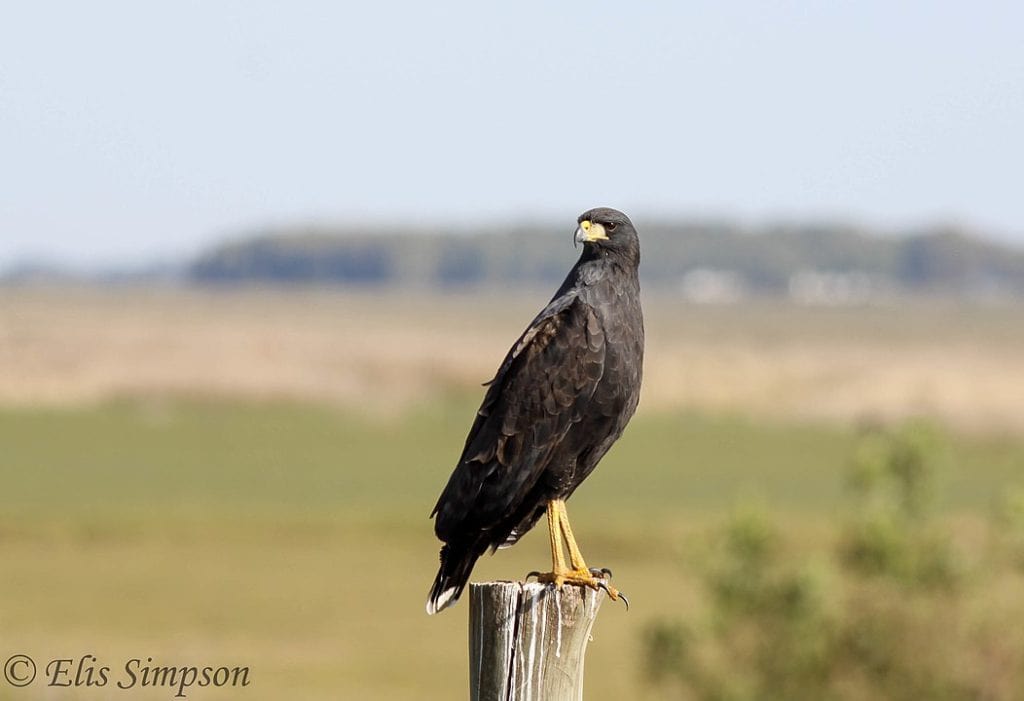
The great black hawks are large, black bodied birds of prey with dark eyes, yellow legs and cere, white and black tails and relatively long yellow legs. The basal half of their tails and upper tail coverts are white.
The great black hawks, often described by researchers as slow-moving, sluggish hawks, are commonly found in Savannahs, open woodlands, mangroves and Forests. Although uncommon, they can also be found in inland waters and swampy oodlands.
The Great Black Hawk can be found feeding on birds, fish, small mammals, large insects, reptiles, poultry, lizards, carrion, crabs, and snakes. They most often hunt by perching and soaring above woodlands searching for their prey; but they also can hunt on foot.
The Great Black Hawks are known for building a large stick nest on trees, and then usually lays one egg, with dark-blotched white.
The adult Great Black Hawk measures up to between 56-64 cm (22-25.2 in) in length, with a wingspan of between 53-127 cm (21-50 in) and weight of between 1100-1300 g (2.4-2.9 lb). Adult male and female great black hawks look alike. However, females tend to be larger than males.
Juveniles on the other hand have dark brown upperparts with streaks and spotting. They also have buff dark-spotted underparts with tails marked with a number of black and dusky bars, and markings of brown on the breast.
11. Northern Goshawk
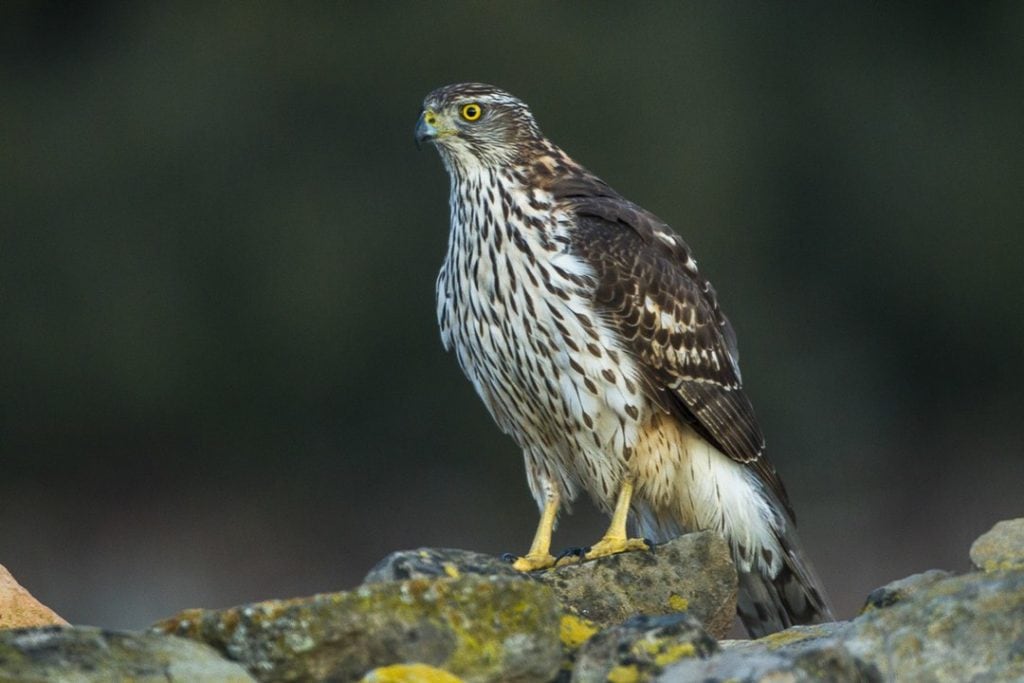
Northern Goshawks are medium-sized raptors with dark heads, red eyes, long tails and rounded broad wings. They have white eyebrows, gray caps, and finely gray-barred bellies.
Adult Northern Goshawks are characterized by their dark slate upperparts and barred pale gray underparts. Females are slightly larger than their male counterparts, with a length of between 53-64 cm (20.9-25.2 in), with a wingspan of 103-117 cm (40.5-46.1 in) and weight of 631-1364 g (1.4-3 lbs).
Juveniles are steaky and brown with indistinct yellow eyes and pale eyebrows, and their tails covered in narrow dark bands.
Goshawks are wild forested birds and therefore can be found in large tracts of coniferous forests and deciduous hardwood forest. During wintering, you will find them migrating to warmer areas.
For nesting, they favor mature forests that consist of old and tall deciduous trees such as ponderosa pine, lodgepole pine, white fir, and Jeffrey pine. The typical clutch size of Northern Goshawks is between two to four bluish-white eggs (roughly texture), laid in an interval of two to three days.
Northern Goshawks are one species of hawks in Florida referred to as sit-and-wait predators. They basically hunt by perching on branches and scoping their habitat landscape for prey and food. During their hunt, they often switch between perches quite a few times.
A Northern Goshawk’s diet consists of mostly small mammals and birds. They primarily feed on birds such as crows and grouse, and mammals such as squirrels, snowshoe hares, rabbits, rodents, and snakes. They also feed on a variety of insects that they find on their path.
12. Ferruginous Hawks
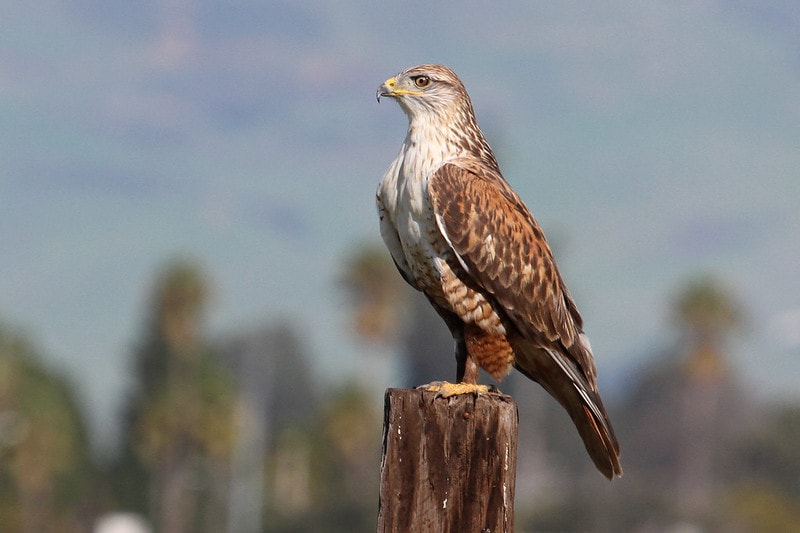
Here comes the largest hawk in Florida – Ferruginous Hawks. They are characterized by their long wings and large heads. The Ferruginous Hawks are a much rarer Hawks; they are so named, following the rust color or ferruginous on their wings.
The Ferruginous Hawks come in a light and dark morph which can be seen in their varying color patterns. The plumage pattern of adult males and females are identical. The easiest way to differentiate them is by size. This hummingbird species is about 56-69 cm (22.1-27.2 in), with a wingspan of 133-142 cm (52.4-55.9 in) and weight of 977-2074 g (2.2-4.6 lbs). Typical of most raptors, the females are larger than the males.
The light morphs are more common, having a white coloration underneath their pale heads, bellies and wings. They have dark legs, with the upper parts of their wings and backs covered in rusty brown. Juveniles of this morph have more spots of brown on their legs and bellies.
The dark morphs on the other hand have their bellies and underwings colored in brown. Their tail and flight feathers on the wingtip are colored in white.
This large hawk species lives in the open spaces such as grasslands, scrubland, prairie, pinyon-juniper woodland edges, and sagebrush steppe. They hunt either on ground, by perching or on the wing. The majority of their diet is made up of small mammals. However, depending on availability, they also feed on cottontail rabbits and jackrabbits, and prairie dogs and ground squirrels.
The nesting site of Ferruginous Hawk usually consists of bushes or trees. This migratory bird also builds on cliff ledges, hay stacks, power poles, dirt piles, power poles and elevated grounds. Their average clutch size is between 1-8 eggs, but usually lays between 3-5 eggs, with incubation lasting about 32-33 days.
13. Rough-legged Hawks
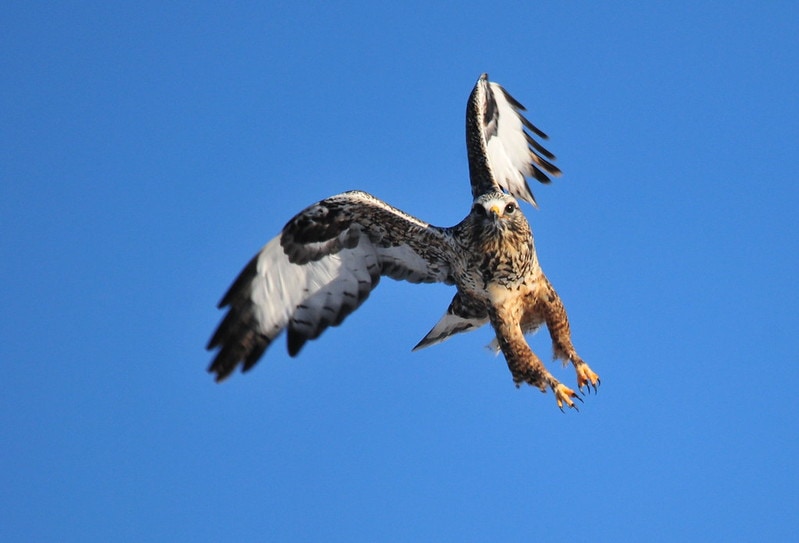
Rough-legged Hawks are relatively large raptors with broad wings and long tails, measuring up to 47-52 cm (18.5-20.5 in), with a wingspan of 132-138 cm (52.0-54.3 in) and weight of 715-1400 g (1.5-3 lb). The name Rough-legged Hawks comes from their characteristic feathered legs, which extends even down to the toes. This adaptation helps them to keep warm in frigid weather.
These hawks occur in open areas such as marshes, deserts, prairies and fields. They breed in the arctic. Nesting is usually done on narrow niches or edges in high cliffs or tall trees, on top of large rocks and on slopes. Their average clutch size is 2-5 eggs, with incubation taking about 31 days.
Similar to some hawks in Florida, Rough-legged Hawks exist in both light and dark morph. Light morphs are characterized by gray upperparts, pale underwings and dark mottling all through their bodies. The females of this morph are whitish, with grayish heads, blackish wrists and bellies, and white tail. Juvenile light morphs are similar to adult females.
Adult dark morphs have dark brown underparts, with darker patches in wrists and bellies, white patches behind the head, and dark gray-blue upperparts. Females have dark tails with broad tips. Juveniles of dark morph have slightly paler bodies, cheeks and eyebrows than the adult females, and gray-banded grayish tails.
Rough-legged Hawks prey mostly on rodents but can vary with seasons. When breeding, they can be found eating voles and lemming; when wintering can be found feeding on small mammals such as ground squirrels, mice, and voles.
you may also like:
Discover different species found in Florida here:

Wild Monkeys In Florida | Poisonous Frogs In Florida | Anoles In Florida | Birds Of Florida | Vultures In Florida | Woodpeckers In Florida | Alligators In Texas | Sharks in Florida | Largest Alligator In Florida | Beach Birds Of Florida | Snakes In Florida | Florida Turtles | Owls In Florida | Lizards In Florida | Florida Spiders | Geckos In Florida | Scorpions In Florida | Florida Frogs | Florida Freshwater Fish |








